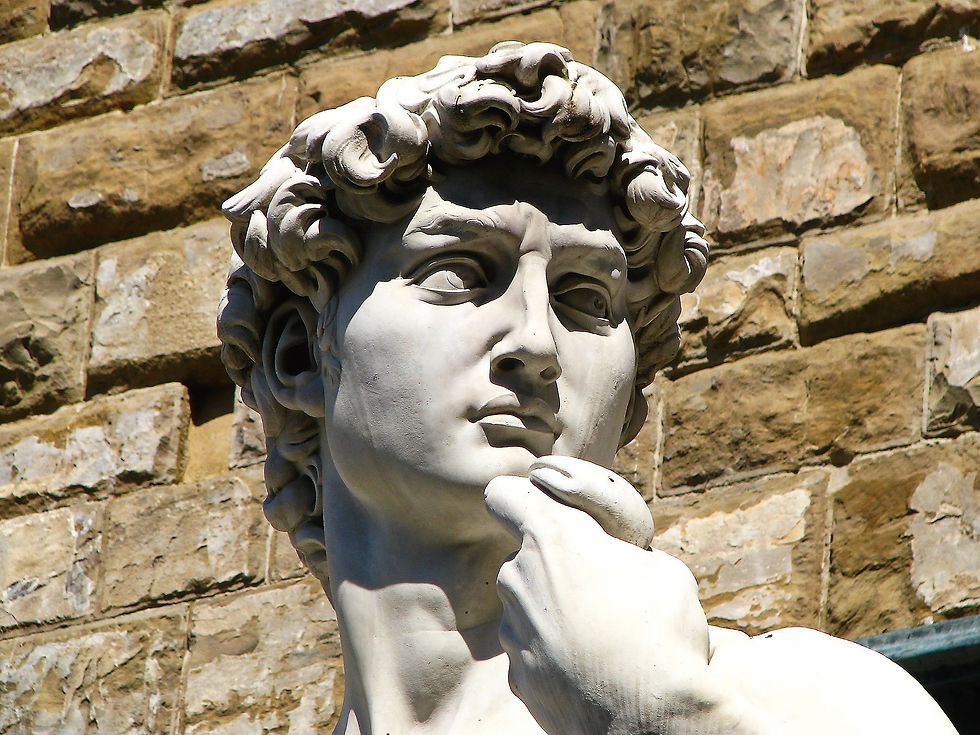Michelangelo's David, Some Facts
- infoflorencetours
- Mar 22, 2020
- 3 min read
Updated: Apr 24, 2023
Michelangelo's David, made between 1501 and 1504 to be placed in Piazza della Signoria as a symbol of the Florentine Republic, alert and victorious against enemies, portrays the biblical hero when he faces Goliath, always considered the perfect ideal of male beauty in art, like the Venus by Sandro Botticelli, considered the canon of female beauty. David, is an authentic masterpiece of Renaissance marble sculpture, as well as a symbol of Florence and Italy abroad.

Artists, enthusiasts, historians and art experts believe that Michelangelo's David is the most beautiful artistic object ever created by man. The sculpture, in five centuries of its existence, has been the subject of much attention, both the positive ones of liking of art lovers and the negative ones of adverse or vandalic circumstances: ⦁ In 1512, lightning struck the base of the statue, which caused quite a few worries about sagging at the ankles, but then ultimately there were no unsolvable damages. ⦁ On April 26, 1527, during the second expulsion of the Medici from Florence there were riots in the Florentine city and a group of Republican Florentines, from the Palazzo Vecchio, to defend themselves from opponents threw stones and other heavy objects from the windows, which went to fall also on David, causing him to shatter his left arm into three pieces and chip the slingshot at shoulder height. ⦁ Giorgio Vasari and Francesco Salviati, great admirers of Michelangelo, collected the fragments of the statue and kept them in Salviati's house. With the return of the Grand Duke Cosimo I, restoration was carried out. The signs of the restoration are still visible. ⦁ In 1813, the middle finger of the right hand was rebuilt following another damage. ⦁ In 1843, the sculptor Lorenzo Bartolini, director of the "Royal Factories", commissioned the restoration of David to Aristodemo Costoli, who carried out the cleaning with questionable methods. To remove the crusts, he used hydrochloric acid-based material and sharp irons that damaged the skin with scratches even two millimeters deep. ⦁ On 29 August 1846, Clemente Papi made the plaster cast which then served as the basis for the future bronze casting of the copy, which is currently located in Piazzale Michelangelo, on the terrace overlooking Florence. ⦁ In 1872, given the precarious conditions of conservation, it was decided to hospitalize the statue in the Galleria dell'Accademia in Florence, where it still stands today. For the new arrangement, the architect Emilio De Fabris was commissioned, who built a new grandstand at the end of the Gallery of Ancient Paintings, with natural lighting, given by a skylight. ⦁ In August 1873, the statue was loaded onto a kind of cart, the model of which is exhibited in the Casa Buonarroti museum. The whole process had been accompanied by the clamor of the people. In the museum it remained closed in its box for nine years, pending the completion of works. In 1875, on the occasion of the fourth centenary of the birth of Michelangelo Buonarotti, an exhibition was organized with the plaster reproductions of his sculptures, and for the occasion the David was provisionally unpacked. ⦁ On July 22, 1882, the Michelangelo Museum was finally inaugurated and the vision of the masterpiece was offered to the public. ⦁ In 1910, David's copy was placed in Piazza della Signoria. ⦁ On 14 September 1991, as his last misfortune, he was damaged with a hammer by a madman named Piero Cannata. A similar event had happened nineteen years earlier at Michelangelo's Pietà. But fortunately the damage to David was much more limited; only the big toe and the first two toes of the left foot were chipped, which was immediately completed using the original fragments. In 2004, a new copy of the statue was offered from Florence to the city of Jerusalem to celebrate the third millennium after David's conquest of the city. The proposal sparked many protests from some Orthodox religious who considered David's nude not worthy of a biblical hero, but too pagan. In the end a compromise was reached, it was decided for a reproduction of the fully dressed Verrocchio.

Comments